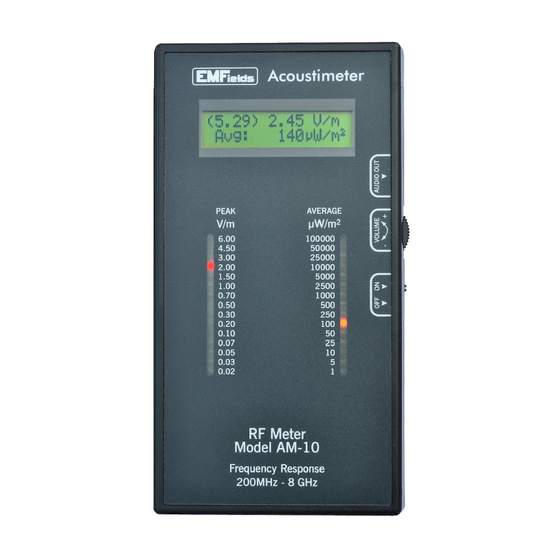
Table of Contents
Advertisement
Quick Links
Advertisement
Table of Contents

Summary of Contents for EMFields AM-10
- Page 1 Acoustimeter User Manual...
-
Page 2: Table Of Contents
(and audio output socket for headphones or an audio recorder), allowing you to determine, with a small amount of practice, what type of device is creating the signals. Sound samples are available http://www.emfields.org/detectors/acoustimeter.asp to help you identify different signals. -
Page 3: Safety Instructions
Safety instructions Please read through these instructions carefully before operating the instrument. It contains important information regarding usage, safety and maintenance. The instrument is not waterproof and should not come into direct contact with water, nor should it be used outdoors in the rain. If it is raining and you want to take measurements outside, ple ase cover the instrument in a plastic bag that does not have holes in it. -
Page 4: Instrument Guide
Instrument guide 1. Display 4. Audio, mono 2.5mm 7. Internal antenna 2. Peak signal LEDs 5. Volume control 8. Loudspeaker 3. Average power LEDs 6. On - Off switch 9. Battery compartment... -
Page 5: Operation
Ensure that you have correctly inserted appropriate batteries (2 x AA cells). Move the power switch into the “On” position. The LCD display should briefly display “Acoustimeter, © EMFields 2009”, changing to readings after a short time. Hold the bottom of the instrument in one hand at least 30cm from your body as close proximity to your body will affect the readings. -
Page 6: Peak & Average - What Are The Differences
Why are there two different readings? The Acoustimeter is unique in the way it displays information about its measurements. There are two different displayed results showing both Peak and Average measurements. At first, this may seem confusing. We believe that it is important to know both when assessing your exposure to modern telecommunication signals. - Page 7 Why does this matter? Since wireless communications were first developed on a large scale, the scientific community held the opinion that “if it does not heat you it will not hurt you”, as 30 years ago these were the only effects that were acknowledged...
-
Page 9: Troubleshooting
Troubleshooting Problem Possible Solutions The instrument is not Check that the power switch is in the “on” position showing any reading Check that the batteries are correctly inserted into the instrument. The Acoustimeter doesn’t The batteries may be flat. Try changing them. If the LCD is displaying a reading, then it is turned on seem to be working and working. -
Page 10: Guarantee
Problem Possible Solutions It still makes a noise when The audio produced by the Acoustimeter is inside a headnet/behind logarithmic in volume, so even quiet signals can my screening seem quite loud. Check the figures that the Acoustimeter is displaying for an accurate measure of how effective your screening is. -
Page 11: Appendix A: Some International Guideline Levels
Appendix A : a comparison of some international guidance levels Frequency E field Power Power General Public Levels µW/m 2000 000 ICNIRP, 1998 4500 000 (recognised by WHO, EU & UK ) 1800 9000 000 2100 10000 000 Russia 2003 (general public), PRChina 300 - 300000 100 000 Italy, Decree 381 (1999) -
Page 12: For Continuous Wave Signals
UK local waste recycling centres also provide free collection points for WEEE. Disclaimer While EMFields considers that the information and opinions given here are sound, you must rely upon your own skill and judgement when interpreting or making use of the information contained in this manual.


Need help?
Do you have a question about the AM-10 and is the answer not in the manual?
Questions and answers